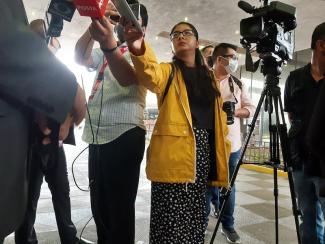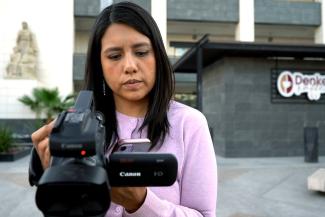QUEST FOR TRUTH
The challenges for Mexican women journalists
Meet Esmeralda Sánchez, Ana Victoria Félix, and Shalma Castillo.
These journalists and many others are working from major Mexican cities along the U.S.-Mexico border. They cover everything from corruption to organized crime to the fate of disappeared persons.
Their job is challenging from the start—Mexico was ranked the deadliest country for media outside of a war zone for the fourth year running in 2022.
Add to that the challenge of being a female journalist in Mexico, and you can understand the tenacity and persistence necessary for all these women to go about their jobs.

“Being a journalist in an environment like the one we live in in Mexico—where censorship is experienced in all spheres, both public and private, and there is a constant threat from power and criminal groups—is a challenge on its own,” said Ana Victoria Felix, a reporter from Monterrey, Nuevo León.
She published articles exposing important oversight, investigation, and accountability failures in local governance, winning the 2021 Border Hub first prize with a colleague for their investigation on stolen scholarships. Border Hub is a USAID initiative through the International Center for Journalists and the Border Center for Journalists and Bloggers.
Her tenacity and that of other journalists shows.
“The most important challenge that I have faced … is to make myself respected as a person, as a professional and as an ethical journalist,” said Esmeralda Sanchez.
She investigated Coahuila’s disappeared persons, with the support of Border Hub, and received an honorable mention from the Border Hub Prize for her work.


Photojournalists Gabriela Perez (top) and Veliz Cruz (bottom left), as well as journalists Rosario Morro (bottom center) and Shalma Castillo (bottom right) have to prepare for every eventuality. As an investigative journalist and editor in Tijuana, Rosario’s talent has shone in reporting on drug trafficking and organized crime, but has also earned her death threats.



As Rosario noted, “Every time we have a threat … in the case of Zeta [newspaper], we go to the different organizations to request support so that they say it out loud, because this way people, be it corrupt officials or criminals, can know that we are not alone.”
She and other journalists have built a community through Border Hub where they can rely on and learn from each other.
Border Hub has also given them the methodology and tools for organizing and planning their reporting, and helped them identify gaps and areas for further investigation. They also now have the tools they need to ensure their digital and physical security.
Globally, both male and female journalists face barriers every day to telling their stories, everything from harassment to imprisonment, threats, and actual injury or death.
With several Mexican journalists having been attacked already in 2023, “it is important that as a society we can move more and more towards a safe space in which all people can express their opinion and build efforts,” said Ana Victoria.

“It’s important that women [specifically] are doing investigative journalism because it opens the door for future generations, and broadens the perspective of other women about what it’s possible to do,” added Jessica Ayala, founder of the independent newspaper La Plaza Pública, a newspaper in the Lagunera Region.
#WORLDPRESSFREEDOMDAY
Learn more about USAID’s work in Mexico on Facebook and Twitter.
ABOUT THIS STORY
Across the Latin America and Caribbean region, USAID works with the International Center for Journalists (ICFJ) to support safe investigative journalism, especially in environments where journalists face threats. Through the Northern Border Investigative Journalism Hub (Border Hub), run by the Border Center for Journalists and Bloggers, USAID supports journalists’ ability to produce responsible, well-sourced, and original investigative reporting that exposes corruption and promotes transparency and accountability in targeted northern border states and municipalities. The activity also helps journalists use necessary digital and physical security protocols to perform their work safely.
Footnotes
Narrative by Jessica Hartl and Oscar Agusil; photos by Alicia Fernández and Fabián Meléndez for USAID




